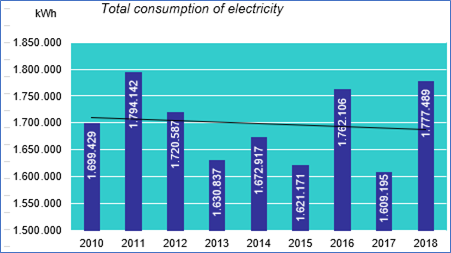Do you know the carbon footprint of your port?
By Jesper Goodley Dannisoee *
2020 April 2: A port is like a factory. And some ports are like large scale industries, servicing vessels of various types, while acting as the main transportation corridor in and out of the country. The commodity could be industrial goods or human cargo a.k.a. tourists.
At first glance, the climatic/environmental footprint of a port may not look like something to worry about. But, the operation and management of a port does add to the negative aspects of climate change and may also have a huge impact on the marine environment as well.
Do you know the climate footprint of your port? Do you know how your port may help to reduce its impact on your country’s (and the regional) environment?
Like an engine that is required to run smoothly and at its optimal best 24/7, in order to fulfil its purpose a port needs to be kept in good shape. ‘Mechanics’ must, therefore, attend to the details and ensure that all processes aspects and components are performing optimally.
Take this analogy and apply it to your port. For your port to work properly, it is necessary to create an overview of the current health of the port and all the consumptions necessary to run the port. To do that, you need to get the heads and tails of it. The first step will be to list all commodities and consumptions into as many categories as necessary. The most obvious examples are:
-
-
- Electricity
- Fuel
- Water
- Solid waste
- Liquid waste
-
For each of the categories, assessments of the annual or seasonal consumption must be made and measured. It is usually easy to measure electricity, water and fuel consumption because they can easily be metered, but it is also important to break the uses down to smaller units: How much electricity is used for the offices, how much for warehouses. By breaking the uses down to the smallest practical units, it will also make it easier to see what each unit is being used for. Does 70% of the electricity go for air conditioning offices, or for cooling warehouses?
The same breakdown is needed for all the others as well, taking the wisdom from the words ‘if you want to manage it, you must be able to measure it’ into account.
 In our company, we have set up individual measuring devices for electricity and for water to enable us to split up our uses. We have been able to see how much we have been using for our servers; for our air-conditioning, workshops and other units; and, we have therefore also been able to go deeper into looking at the power consumption on, for example, pumps, air conditioners and servers. In order to reduce our consumption of electricity, we have made lists of the power-consuming entities and we have calculated whether or not it would be an advantage to change the equipment to lower the consumption, compared with the costs of new equipment (lifecycle assessment).
In our company, we have set up individual measuring devices for electricity and for water to enable us to split up our uses. We have been able to see how much we have been using for our servers; for our air-conditioning, workshops and other units; and, we have therefore also been able to go deeper into looking at the power consumption on, for example, pumps, air conditioners and servers. In order to reduce our consumption of electricity, we have made lists of the power-consuming entities and we have calculated whether or not it would be an advantage to change the equipment to lower the consumption, compared with the costs of new equipment (lifecycle assessment).
GRAPH CAPTION: Example of the energy consumption over 9 years at DHI, showing large differences from year to year. Observe the trend line indicating a decrease the electricity consumption over the nine years.
“Greening of the port must start with clean air and reduction of emissions.”
All the above can be used to develop a Green Account, where you can add in all your consumptions and start comparing year-to-year. This enables you to see the effects of changing behaviours, replacing old and power-consuming equipment with new, less-consuming equipment. In our daily life, we tend to do things that might lead to unnecessary consumption of resources without thinking about it, such as:
- turning on the air conditioner, even if it might not be necessary;
- running the air conditioner too cold;
- not having building insulation against warm weather;
- washing cars with pure drinking water;
- letting taps run while not using the water;
- not repairing dripping faucets and running toilets;
- allowing truck and crane motors to run idle; and
- not handling waste disposal properly.
SET UP A PLAN
If you want to move “greener”… and science makes it obvious that you must… then set up a plan and make sure all your port staff are actively engaged. You may even find out that changing behaviour reduces costs, enabling new investments. Above all it will be a positive step towards ultimately decreasing the climate footprint of the port.
Next time you need to purchase new equipment, regardless of what it is, make sure that your suppliers provide you with an overview of power, fuel, or other consumptions, so that you can choose the most effective.
In the water sector, we talk a lot about lifecycle calculations. Those principles may advise that you buy the most expensive pump, e.g., because it will use less energy during its 20-year lifetime. And, because of less repair being necessary, that altogether, the most expensive would be a wise investment.
Do not expect that “greening” your port will come for free. But, consider using the work as part of your promotion. You may even find opportunities to develop principles and regulations, which you could push visiting vessels to adhere to when they are in your port.
Greening of the port must start with clean air and reduction of emissions.
This should also employ strategies to reduce power consumption so as to reduce polluting the local environment; and/or proper waste management to ensure maximum recycling. And since most ports in the Caribbean are highly integrated with their cities, it is suggested that you try to involve the local community to take part in not just thinking about a greener future but also to actually take part in the attempt to reduce the footprint.
The Port Management Association of the Caribbean (PMAC) could lead the way in developing some kind of benchmark for PMAC member-ports. The benchmarks could be: the total costs (energy, fuel, water, etc.) to handle one 20-foot container (or 100 cruise passengers; or one ton of goods). It may not be easy but it would likely show a large difference between ports; and, where some of the differences also comes from (age of the port, equipment and handling procedures).
It would not be a competition. That is not the idea. It would however be a first step to creating a learning environment, wherein ideas and experiences are shared for the benefit of all the ports within and without the Caribbean. []
 *Jesper Goodley Dannisoee is a Biologist at DHI.
*Jesper Goodley Dannisoee is a Biologist at DHI.
________________________________________________





